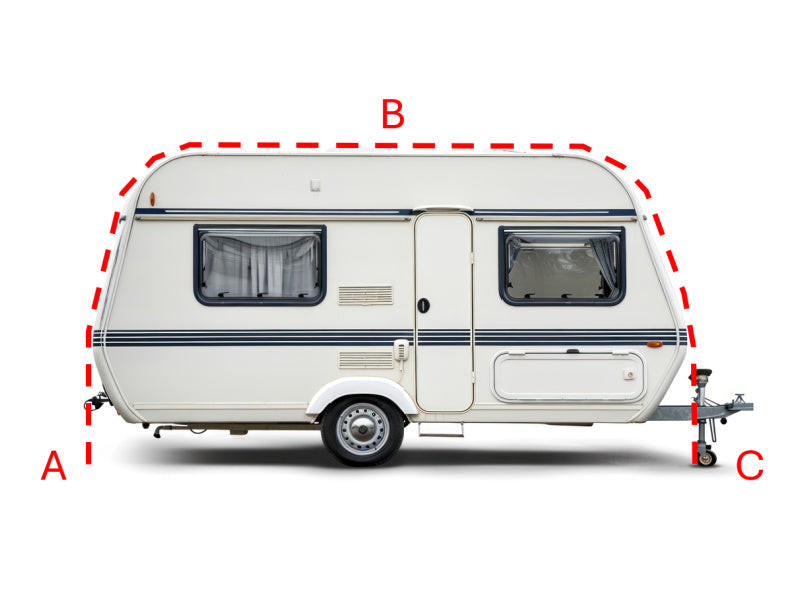How to Repair an Air Awning
Ever discovered your air awning has sprung a leak just as the British weather decides to test its mettle? Don't panic! Repairing air awnings is simpler than you might think. With basic tools and our guide, you'll fix common issues like tears and leaks in no time. Your camping adventures await!
Common Air Awning Problems & Troubleshooting
Air awnings transform camping experiences, but they occasionally need some TLC. Understanding common issues saves time and money while extending the life of these valuable accessories.

Identifying the Issue: Leaks, Deflation, Rips & Tears
The key to successful repairs lies in spotting problems early. Much like a slow puncture in a bike tire, small issues with air awnings can develop into bigger headaches when left unchecked.
Visual Inspection: Checking for Holes and Tears
Start with a thorough once-over of the awning fabric. Look for obvious damage like snags, holes, or worn patches. Pay extra attention to corners and areas that rub against the caravan.
Morning light works best for spotting small holes - the sun shining through makes even tiny punctures visible. Remember to check both sides of the fabric.
Inflation Tests: Identifying Air Leaks
The trusty soapy water method reveals sneaky leaks that eyes might miss. Mix washing-up liquid with warm water, inflate the awning, and brush the solution over suspicious areas.
Bubbles will form where air escapes - mark these spots with chalk or masking tape. This old-school technique hasn't failed since caravanners first started using it decades ago.
Examining Seams and Zippers
Seams and zippers often give out first, especially in British weather. Run fingers along each seam, feeling for loose threads or separating material.
Zippers should move smoothly without catching. Stuck or corroded zippers need attention before they fail completely.
Troubleshooting Common Problems
Dealing with Leaks: Patching and Sealing
Think of leaks like holes in a boat - they need fixing before the next adventure. Small leaks might only need sealant, while larger ones call for proper patches.
Always work on a flat, clean surface. The repair area needs to be bigger than the damage - imagine putting a plaster on a cut, but with more overlap.
Addressing Deflation: Checking Valves and Pumps
Deflation frustrates many campers, but the solution often lies in the valves. Check for debris caught in valve mechanisms or damage to valve seals.
Connection points between pumps and valves frequently cause issues. A quick clean and proper alignment usually sorts these problems.

Repairing Rips and Tears: Patching Techniques
Tears need swift attention to prevent spreading. The approach varies based on size and location - smaller tears might need only tape, while larger ones demand proper patches.
Step-by-Step Air Awning Repair Guide
Preparing for the Repair
Gathering Necessary Tools and Materials
Every successful repair starts with the right kit. Essential items include:
-
Repair patches matching the awning material
-
Appropriate adhesives for outdoor use
-
Gentle cleaning solutions
-
Soft brush for cleaning
-
Measuring tape
-
Sharp scissors
-
Clean cloths
Choosing the Right Repair Kit
Manufacturer-specific repair kits typically offer the best results. These kits contain materials tested specifically for their awnings.
Generic repair kits can work in a pinch, but check compatibility with the awning material first. The wrong adhesive could make matters worse.
Preparing the Awning for Repair
Clean surfaces make for lasting repairs. Remove dirt, grass, and debris from the repair area using gentle cleaning solutions.
Let everything dry completely - moisture ruins adhesion. British weather might mean moving indoors for repairs.

Repairing Common Damages
Patching Small Holes and Tears
Small repairs need the same care as big ones. Cut patches with rounded corners to prevent lifting - sharp corners catch on things and peel up.
Press firmly when applying patches, working from the centre outward to remove air bubbles. Think of it like applying a screen protector to a phone.
Sealing Seams and Zippers
Seam repairs prevent water ingress and maintain structural integrity. Apply seam sealant in a thin, even bead along problem areas.
Zipper maintenance matters too. Clean tracks with an old toothbrush, then apply suitable lubricant to restore smooth operation.
Repairing Larger Rips and Tears
Bigger tears need patches on both sides when possible. This sandwich approach provides maximum strength and durability.
Allow plenty of time for adhesives to cure - rushing repairs leads to failures. Most adhesives work best in moderate temperatures.
Reinforcing Weak Spots
Prevention beats cure every time. Reinforce high-stress points before they fail - corners, valve surrounds, and tension points need extra attention.
Preventative Maintenance for Air Awnings
Regular Cleaning and Inspection
Washing and Drying Tips
Regular cleaning extends awning life significantly. Use warm water and mild soap - harsh chemicals damage protective coatings.
Rinse thoroughly to remove all soap residue. Allow complete drying before storage to prevent mold and mildew.
Checking for Wear and Tear
Regular checks catch problems early. Look for stress marks, wear patterns, and early signs of material fatigue.
Proper Storage and Handling
Folding and Storing Techniques
Proper storage prevents unnecessary damage. Follow the manufacturer's folding pattern - random folding creates permanent creases.
Store in a cool, dry place away from direct sunlight. Use breathable storage bags rather than plastic containers.
Protecting from Weather and UV Rays
UV damage weakens fabric over time. Use covers or take down awnings during extended periods of strong sunlight.
Wind poses particular risks to air awnings. Take them down if strong winds threaten - better safe than sorry.
Choosing the Right Repair Materials
Selecting Suitable Patches
Match patch materials to the awning fabric. Consider thickness, flexibility, and weather resistance when selecting patches.
High-quality patches cost more but last longer. Cheap alternatives often need replacing sooner.
Choosing the Right Adhesives
Use only recommended adhesives. Weather-resistant formulations designed for outdoor use provide the best results.
Temperature affects adhesive performance - check the manufacturer's guidelines for optimal application conditions.
Considering Reinforcing Tapes
Reinforcing tape adds extra strength to repairs. Apply to both sides of seams or stress points for maximum durability.
When to Seek Professional Help
Extensive Damage
Some repairs need professional attention. Signs include:
-
Tears longer than 30 centimetres
-
Multiple damage points close together
-
Complex structural issues
Structural Issues
Don't risk safety with DIY repairs when:
-
Air beams show damage
-
Framework appears compromised
-
Valve problems persist after basic maintenance
Safety Concerns
Professional help becomes essential if:
-
Repairs might affect stability
-
Damage occurs at crucial support points
-
Any doubt exists about repair safety
Remember: maintaining an air awning properly saves money and extends its life. Regular checks, prompt repairs, and proper storage make all the difference.
Other content you might like:
- How to put up an air awning
- How to attach an air awning to caravan
- How to deflate an air awning
- How to stop air awning sagging
- How does an air awning work?
- Air awning instructions
- How to take down an air awning





Leave a comment